There is a lot to cover on Wednesdays. We should know, as collectively, we read an insane amount of comics. Even with a large review staff, it’s hard to get to everything. With that in mind, we’re back with Wrapping Wednesday, where we look at some of the books we missed in what was another great week of comics.
Let’s get this party started.
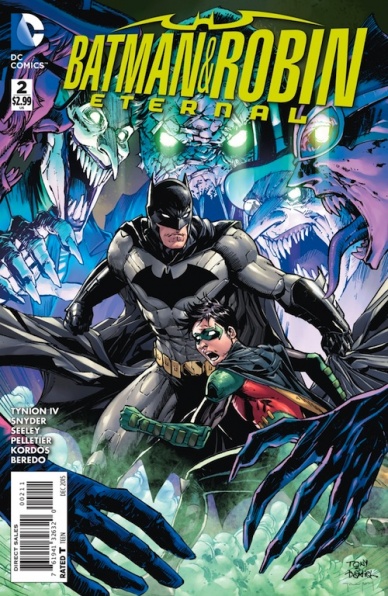
Batman and Robin Eternal #3
Written by Tim Seeley
Illustrated by Paul Pelletier
Reviewed by Keith Dooley
Week two of the new Bat-weekly has plenty of action, a deepening of the central mystery, and characters coming together that elicit nostalgic joy from this longtime reader. Like the first issue of “Batman and Robin Eternal”, this weekly can so far be picked up by new readers without any confusion. One of Batman and the original Robin’s (Dick Grayson) early cases come back to haunt Dick and the rest of the Bat-crew (sans an amnesiac Bruce Wayne) with the mysterious re-introduction of Cassandra Cain teasing a larger role in the future of Gotham’s caped denizens. With a rotating roster of writers for its twenty six issues, this issue is ably written by Tim Seeley. The pace is quick and it feels like it ends too soon, but Seeley packs enough humor and action to make this chapter a fun little treat. Seeing Tim Drake and Stephanie Brown on the same page once again made my heart flutter. Newbies will understand why these classic characters have such a loyal following and get further setup for future issues.
The second issue is penciled by Paul Pelletier and inked by Tony Kordos. Their work is smooth and clear, with their pages reminiscent of Ivan Reis and Joe Prado. Except for a few rushed panels, the art is uncluttered and focuses on detailed and dynamic action as well as conversational moments where characters’ emotions are effectively expressed. The humor that Seeley brings to the script is depicted nicely and especially in scenes involving Dick and Tim. Character is the focus for Pelletier and Kordos. Although nothing too intense happens, the flashback allows for artist and inker (as well as colorist) to conjure up some hallucinogenic scenes of terror.
Colorist Rain Beredo does a magnificent job of making the simplest of scenes pop with vitality. Cassandra’s uniform is intricately colored and lends heft to the artistry of Pelletier and Kordos. The blood on the Orphan’s outfit looks caked in and the blood’s texture has a 3-D effect that makes the comic page appear stained. Every moment, from the few panels with Matron talking to Dick from Spyral headquarters to Stephanie observing Dick’s fluid and sexy movements in a humorous scene, are colored with a mixture of realism and the larger than life that is required of a tale that requires both moments of intensity and intimate encounters.
“Batman and Robin Eternal” #2 has less “wow” moments and may seem unimportant to the overall story. Yet it is important for those smaller moments that reveal character and the beginning of a promising team-up of Robins and other Bat-family members.
Final Verdict: 7.9 – Although it may not be an essential issue, “Batman and Robin Eternal” #2 is proof of the appeal of these characters.
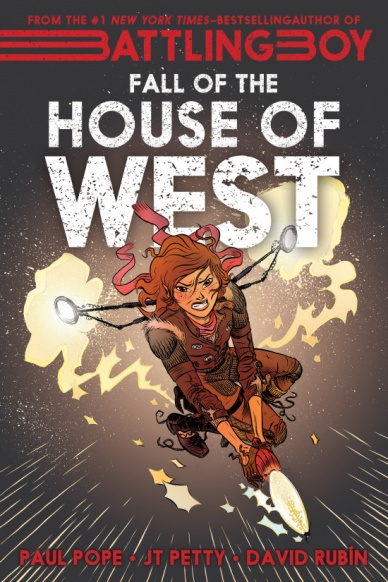
Battling Boy: The Fall of the House of West
Written by Paul Pope & J. T. Petty
Illustrated by David Rubín
Reviewed by Matthew Garcia
In the follow-up to last year’s, “The Rise of Aurora West,” a spinoff prequel series and nominally the third part of Paul Pope’s “Battling Boy” saga, we find our titular hero tracking down the perceived killer of her mother and learning plenty of new information about her family. Written by Paul Pope with J. T. Petty and illustrated by David Rubín (recently of “The Fiction” with Curt Pires), “The Fall of the House of West” is an effective prequel. It does well in delivering intense action, establishing Aurora’s character for the main series, and helping set the stage for “Battling Boy.”
The biggest joys of this book come from watching Aurora’s resourcefulness grow. She stumbles through rough situations, she makes a ton of mistakes, she can sometimes be a jerk to the people around her, but we see her grow and come away from it as a new person each and every time. Rubín’s far more comfortable drawing her here and he takes more liberties with her demeanor and expressions; Aurora becomes even more interesting because of it.
Continued belowRubín’s also far more settled into this world, and “The Fall of the House of West” satisfyingly expands on Arcopolis and its monster infestation. His style is loose, unhinged, and he gives this raw energy to the book. His art doesn’t look like Pope’s, but it bears enough of Pope’s hallmarks to help establish it as part of this series. The action scenes are fun and never too brutal and the mysterious elements are genuinely intriguing. The manga-sized format also serves the story well, making it feel brisk, fast-paced, and always exciting.
“The Fall of the House of West” does serve as an effective prequel, I think. Like when I talked about “Sandman Overture”, a prequel can only go so far, and exists sort of as a means to set the stage for the main story. It’s all about the pieces being moved into place: the staging of Sadisto’s gang to take out Haggard West; the explanation of how Aurora West behaves in her brief scenes in “Battling Boy.” And I think it’s the only way I can explain the ending of this book. Because this book bears an incredibly odd ending, talking about protecting heroes from the liability of reality, of keeping them ignorant and singular. I don’t think the end of “The Fall of the House of West” is a good ending for this series, but it’s an interesting place to leave Aurora before continuing her arc in “Battling Boy.”
Final Verdict: 7.6 – interesting character work and well done action help to develop the “Battling Boy” world, and make us even more excited for “Battling Boy” Part 2.
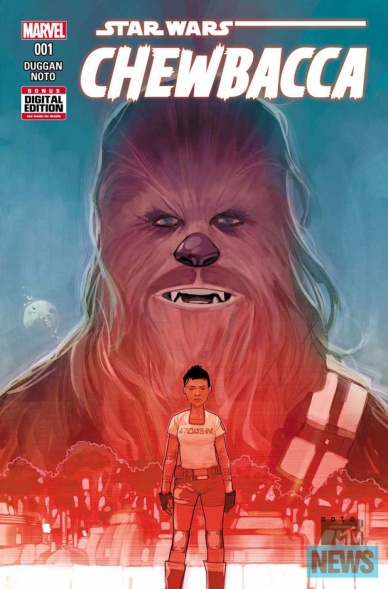
Chewbacca #1
Written by Gerry Dugan
Illustrated by Phil Noto
Reviewed by Alice W. Castle
Chewbacca is one of the most recognised, most loved, most imitated characters in all of Star Wars and yet what’s interesting is that he’s never spoken a word of English. How, then, do you write a comic entirely about him?
Well, in Gerry Dugan and Phil Noto’s first issue, what you do is you introduce a new protagonist with a tragic backstory and a problem that only a Wookiee can solve.
Duggan and Noto do a great job balancing introducing this new protagonist and tying her story to Chewie’s with some great character moments and one hell of an ending that cements Chewbacca as the most low key tragic yet heroic characters in Star Wars.
Final Verdict: 7.6 – A solid introduction that has me intrigued for what comes next.
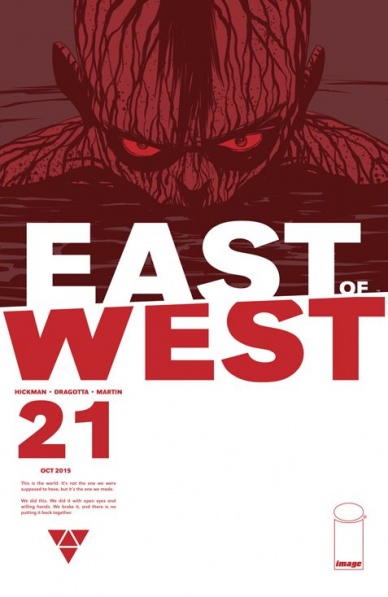
East of West #21
Written by Jonathan Hickman
Illustrated by Nick Dragotta
Review by Ken Godberson III
There is a saying with some comics that they are best read in trade. Some even say that writers like Jonathan Hickman are best read in omnibuses. I say this because, while this issue does a great deal of not only building the world around The Nation of the American Endless and their machines as well as provide some answers to questions from way back in arc 2 and some good character work, the book is still traveling at its very steady pace, unhelped by delays.
Nick Dragotta and Frank Martin continue to dominate on this book. From the designs of the Nation’s bizarre technologies to the return of a spiritual character that’s been gone for a while to simple landscapes, there is no other team that could pull of the bleak, weird world of this book. Even in this book where they draw a bit of intimacy, it is juxtaposed with death in a hauntingly beautiful way.
Final Verdict: 6.9- Some good world building for the Nation and some good artwork. The delays are really hampering the book.
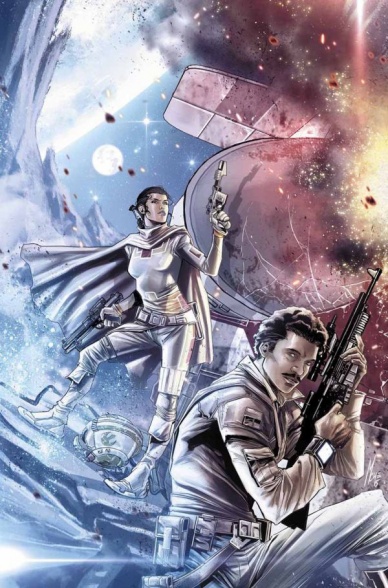
Journey to Star Wars: The Force Awakens – Shattered Empire #4
Written by Greg Rucka
Illustrated by Marco Checchetto and Angel Unzuta
Reviewed by Brian Salvatore
Marvel’s Star Wars books have all been excellent, and quite well received thus far, but all have been going over territory that we’ve not necessarily seen before, but didn’t bring the characters to new places. We’ve been seeing the connective tissue, more than a new story. Well, “Shattered Empire” has changed all of that, and this issue begins the long, and probably thankless, work of connecting all three trilogies together – the prequels, the classic, and the new.
Continued belowThis issue, which brings Princess Leia to her (seemingly unknown) ancestral home of Naboo, attempts to have Leia as the bridge between the three trilogies, and it more or less works. Which I don’t think Rucka quite has a handle on her voice as well as he does on some other characters’, he incorporates a number of important character traits in her that allow for Leia to still shine through, even when her words don’t exactly match the character’s past. Hinting at her Jedi connection, and bringing in a small tease of the prequel’s favorite character, added some depth to the issue.
I didn’t love having the third act spoiled by the cover – the arrival of Lando should (and tried to) emulate Han’s arrival at the end of A New Hope, but the cover featuring him means that it is never in doubt who is going to save the envoy. There was also some convenient plot holes dug by Rucka – like the jamming devices just somehow not working on the ships – but overall, the issue continues the series’ mission of telling a new story that will serve the upcoming film.
Artistically, this is what we’ve come to expect from the Marvel Star Wars books – art that, sometimes, cares too much about matching the actors’ faces, rather than being expressive storytelling. Sure, Leia and Lando and Han all look ‘perfect,’ but they also lack real emotion in their faces, as Checchetto seemingly is focused more on the likeness than the storytelling. This appears to be somewhat of a mandate from the Marvel/Lucasfilm offices, and while I understand it from a sales point of view, it is hurting the comics a little. Most of the books, “Shattered Empire” included, manage to work despite it, but I can only imagine what the books would look like if that wasn’t such a prominent part of the artwork.
Final Verdict: 6.7 – There are a million balls to keep in the air for a book like this, and Rucka and Checcetto keep most of them up without incident.

Spider-Gwen #1
Written by Jason Latour
Illustrated by Robbi Rodriguez
Reviewed by Jess Camacho
“Secret Wars” is almost over and if you’re a regular reader of the site, you’ll know that I’m a regular contributor to our “Secret Wars” review column. I’m a little tired of reading Marvel at the moment but one of the very few ongoings I still care about is “Spider-Gwen”. The second “Spider-Gwen” #1 feels like a continuation of the first volume of this series. Gwen is still Spider-Woman while trying to evade the police. She’s mostly trying to move on from this as she’s moved out and gotten a new job. The main focus of this issue however is the return of the Lizard. Peter Parker in this world was the Lizard and with sightings being reported, Gwen becomes haunted by what is effectively her Uncle Ben. Latour writes a really nice issue but it doesn’t really feel like a #1. It’s easy enough to get into thanks to the intro page and the biography in the back but for someone new, they might feel like they’re coming into something that’s been too established. For me, I’m on board fully but again, I’ve been reading the series since it started. What’s great about “Spider-Gwen” is that while it hasn’t fully captured the perfection of the initial one-shot, it still feels like the most unpredictable series Marvel is putting out. Latour and Rodriguez can do whatever they want with these characters and the last page is just that. It’s an exciting tease that will probably make all the right people angry.
Robbi Rodriguez’s art is really special. It’s so stylized and different from anything happening in any of the other Spidey books. There’s an amazing amount of expression in each panel Rodriguez draws. He has really tight character designs but most importantly, he knows how to draw a Spider-Woman costume. So many artists come into this world and they don’t proportion the character right in the costume or they forget it’s fabric. Rodriguez doesn’t have this problem. The action is kinetic and he uses the right angle to make the web swinging work just right. Renzi’s colors are the perfect compliment to the pencils. The neon colors in contrast to some of the more flat ones is a perfect combo for this story and creates a very specific “dramedy” like tone.
Final Verdict: 7.7 – A very strong issue for those caught up and a still understandable one for new fans.






